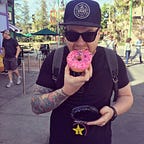Nike and Gillette vs. The World
The power of creating a villain in your story.
Already this year, we’ve had two powerful commercial campaigns cause a bit of an uproar on social media.
First, Gillette released their We Believe commercial, challenging men to hold themselves to a higher standard and challenge toxic masculinity. The commercial seemed out of place for a razor brand, but immediately went viral with more than 4 million views on YouTube in 48 hours. Viewers were split down the middle between loving the ad or feeling like they’re being targeted by the ad, with many people declaring that they’ll be switching razor brands now. Hashtag triggered.
Then, Nike released its Dream Crazier ad during the 2019 Oscars award show. The spot, narrated by Serena Williams, serves to make one point: If you call a woman crazy, she’ll just show you what “crazy” can do. Unlike the Gilette spot, the Nike commercial has mostly been met with acclaim. If there’s one thing Nike knows how to do, it’s using a hot topic to their advantage to position themselves as a progressive brand in a rudimentary world.
After watching the Nike spot a few times, it suddenly dawned on me…
This commercial is Nike drawing a line in the sand, and using that line to create groups of people that can represent heroes and villains.
The line in the sand separates two groups: Those that think men run the world and Those that think women run the world. Nike isn’t just drawing the line, they’re clearly demonstrating that they stand with the latter, and anyone standing on the former has to admit to being the villain in this particular story. But why do they create these villains?
The Role of a Villain
A brief introduction to villains and heroes
Villains are critical characters in almost any story. Without a villain, there is no hero. Without the Joker, there is no Batman. Pay attention to these two stories, though… because these commercials weren’t designed to make Nike and Gilette the hero. They were designed to allow social media users to show the world that they’re the heroes. Nike and Gillette are just the guides helping the heroes vanquish bad taste.
Something to Learn from Nike
Seperating the herd
What does Nike CEO Phil Knight say about drawing a line in the sand and risk having people abandon his brand?
“It doesn’t matter how many people hate your brand as long as enough people love it.”
Nike is making a safe bet that the majority of their customers share their same views, so they’re not risking offending their core audience…they’re just giving them the ability to voice their opinions through a brand that shares their values. Consumers love brand stories that allow them to be the heroes in the story. When someone clicks that share button on Facebook, they’re screaming from their digital rooftop “HEY, THESE ARE MY VALUES, AND I STAND BY THEM”. This isn’t a conversation already widely happening on social media… it needed a brand as powerful as Nike or Gillette to come in and point out the hypocrisy and guide the heroes.
In the wake of the #MeToo and Time’s Up movements, it should be no surprise that big brands are recognizing that 2019’s villain would be anyone standing in the way of a woman and her success. And Nike isn’t leaving much to the imagination; declaring 2019 the year for women.
Villains Allow Heroes to Express Their Values and Beliefs
Dialing in on the values that your customers hold
Gone are the days of feature-based advertising. Today’s consumers, especially Gens Y and Z, are aligning with brands that share their same values. Considering that 18- to 34-year-olds make up only 30% of the American population, but represent 43% of Nike’s customers, you can see why these brands are telling stories regarding their beliefs and values rather than their features and benefits.
Now, your new pair of Nikes aren’t just a pair of trainers for the gym, but also the weapons necessary to defeat our dastardly villain.
When our team is strategizing brand messaging concepts for our clients, we always start with a framework built around discovering who or what the villain is in their story. Companies love to come in hot with messaging that talk about their features. I don’t blame them; they’re super passionate about this really cool thing they just created from a pipe dream they had 5 years ago. But nobody is sharing stories about your product features.
Nobody is going to give you the time of day because your products are made out of recycled plastic. But tons of people will share a story that paints plastic waste as an evil villain that they need to destroy with your brand by their side.
The tides are changing. Fashion brands are finding success by featuring a variety of body shapes and ethnicities in their advertising, portraying an inclusive, body-positive belief system. Brands like ThirdLove have positioned themselves as the weapon consumers can use against the archaic views of lingerie giant Victoria’s Secret…and there’s a Justice League of lingerie brands joining forces to destroy that villain, too.
To create a truly remarkable brand or campaign, look at the villains your customers are battling, and ask yourself where you can equip them with the tools to be victorious.
Thank you for reading! Share your thoughts on the villain/hero strategy or tell me how much I suck in the comments below. Check out my agency Oh Hello to see more of what we’re creating for our friends and clients.
